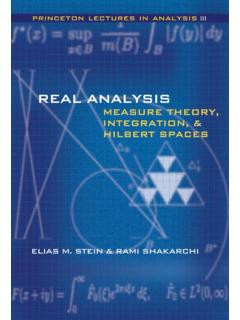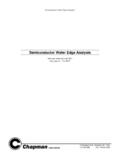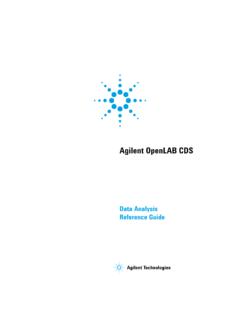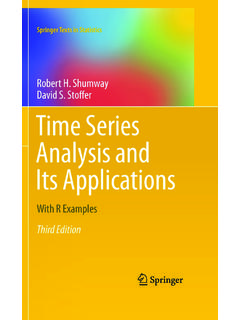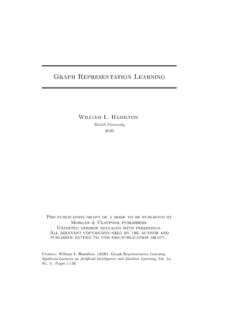Transcription of Functional Analysis, Sobolev Spaces and Partial ...
1 UniversitextFor other titles in this series, go CHaim BrezisFunctional analysis , Sobolev Spaces and Partial Differential EquationsHaim BrezisDistinguished ProfessorDepartment of MathematicsRutgers UniversityPiscataway, NJ m rite, Universit Pierre et Marie Curie (Paris 6) andVisiting Distinguished Professor at the TechnionEditorial board:Sheldon Axler, San Francisco State UniversityVincenzo Capasso, Universit degli Studi di MilanoCarles Casacuberta, Universitat de BarcelonaAngus MacIntyre, Queen Mary, University of LondonKenneth Ribet, University of California, BerkeleyClaude Sabbah, CNRS, cole PolytechniqueEndre S li, University of OxfordWojbor Woyczy ski, Case Western Reserve UniversityISBN 978-0-387-70913-0 e-ISBN 978-0-387-70914-7 DOI New York Dordrecht Heidelberg LondonLibrary of Congress Control Number: 2010938382 Mathematics Subject Classification (2010): 35 Rxx, 46 Sxx, 47 Sxx Springer Science+Business Media, LLC 2011 All rights reserved.
2 This work may not be translated or copied in whole or in part without the written permission of the publisher (Springer Science+Business Media, LLC, 233 Spring Street, New York, NY 10013, USA), except for brief excerpts in connection with reviews or scholarly analysis . Use in connec-tion with any form of information storage and retrieval, electronic adaptation, computer software, or by similar or dissimilar methodology now known or hereafter developed is use in this publication of trade names, trademarks, service marks, and similar terms, even if they are not identified as such, is not to be taken as an expression of opinion as to whether or not they are subject to proprietary on acid-free paperSpringer is part of Springer Science+Business Media ( )To Felix Browder, a mentor and close friend,who taught me to enjoy PDEs through theeyes of a Functional analystPrefaceThis book has its roots in a course I taught for many years at the University ofParis.
3 It is intended for students who have a good background in real analysis (asexpounded, for instance, in the textbooks of G. B. Folland [2], A. W. Knapp [1],and H. L. Royden [1]). I conceived a program mixing elements from two distinct worlds : Functional analysis (FA) and Partial differential equations (PDEs). The firstpart deals with abstract results in FA and operator theory. The second part concernsthe study of Spaces of functions (of one or more real variables) having specificdifferentiability properties: the celebrated Sobolev Spaces , which lie at the heart ofthe modern theory of PDEs. I show how the abstract results from FA can be appliedto solve PDEs. The Sobolev Spaces occur in a wide range of questions, in both pureand applied mathematics. They appear in linear and nonlinear PDEs that arise, forexample, in differential geometry, harmonic analysis , engineering, mechanics, andphysics.
4 They belong to the toolbox of any graduate student in , FA and PDEs are often taught in separate courses, even thoughthey are intimately connected. Many questions tackled in FA originated in PDEs (fora historical perspective, see, , J. Dieudonn [1] and H. Brezis F. Browder [1]).There is an abundance of books (even voluminous treatises) devoted to FA. Thereare also numerous textbooks dealing with PDEs. However, a synthetic presentationintended for graduate students is rare. and I have tried to fill this gap. Students whoare often fascinated by the most abstract constructions in mathematics are usuallyattracted by the elegance of FA. On the other hand, they are repelled by the never-ending PDE formulas with their countless subscripts. I have attempted to presenta smooth transition from FA to PDEs by analyzing first the simple case of one-dimensional PDEs ( , ODEs ordinary differential equations), which looks muchmore manageable to the beginner.
5 In this approach, I expound techniques that arepossibly too sophisticated for ODEs, but which later become the cornerstones ofthe PDE theory. This layout makes it much easier for students to tackle elaboratehigher-dimensional PDEs previous version of this book, originally published in 1983 in French and fol-lowed by numerous translations, became very popular worldwide, and was adoptedas a textbook in many European universities. A deficiency of the French text was theviiviiiPrefacelack of exercises. The present book contains a wealth of problems. I plan to add evenmore in future editions. I have also outlined some recent developments, especiallyin the direction of nonlinear user s guide1. Statements or paragraphs preceded by the bullet symbol are extremely impor-tant, and it is essential to grasp them well in order to understand what Results marked by the star symbol can be skippedby the beginner; they are ofinterest only to advanced In each chapter I have labeled propositions, theorems, and corollaries in a con-tinuous manner ( , Proposition is followed by Theorem , Corollary ,etc.)
6 Only the remarks and the lemmas are numbered In order to simplify the presentation I assume that all vector Spaces are overR. Most of the results remain valid for vector Spaces overC. I have added inChapter 11 a short section describing similarities and Many chapters are followed by numerous exercises. Partial solutions are pre-sented at the end of the book. More elaborate problems are proposed in a separatesection called Problems followed by Partial Solutions of the Problems. Theproblems usually require knowledge of material coming from various have indicated at the beginning of each problem which chapters are exercises and problems expound results stated without details or withoutproofs in the body of the the preparation of this book I received much encouragement from two dearfriends and former colleagues: Ph. Ciarlet and H. Berestycki. I am very grateful toG. Tronel, M.
7 Comte, Th. Gallouet, S. Guerre-Delabri re, O. Kavian, S. Kichenas-samy, and the late Th. Lachand-Robert, who shared their field experience in dealingwith students. S. Antman, D. Kinderlehrer, and Y. Li explained to me the backgroundand taste of American students. C. Jones kindly communicated to me an Englishtranslation that he had prepared for his personal use of some chapters of the originalFrench book. I owe thanks to A. Ponce, Nguyen, H. Castro, and H. Wang,who checked carefully parts of the book. I was blessed with two extraordinary as-sistants who typed most of this book at Rutgers: Barbara Miller, who is retired, andnow Barbara Mastrian. I do not have enough words of praise and gratitude for theirconstant dedication and their professional help. They always found attractive solu-tions to the challenging intricacies of PDE formulas. Without their enthusiasm andpatience this book would never have been finished.
8 It has been a great pleasure, asPrefaceixever, to work with Ann Kostant at Springer on this project. I have had many oppor-tunities in the past to appreciate her long-standing commitment to the author is partially supported by NSF Grant BrezisRutgers UniversityMarch 2010&RQWHQWV3 UHIDFH YLL 7KH +DKQ %DQDFK 7 KHRUHPV ,QWURGXFWLRQ WR WKH 7 KHRU\ RI&RQMXJDWH &RQYH[ )XQFWLRQV 7KH $QDO\WLF )RUP RI WKH +DKQ %DQDFK 7 KHRUHP ([WHQVLRQ RI/LQHDU)XQFWLRQDOV 7KH *HRPHWULF )RUPV RI WKH +DKQ %DQDFK 7 KHRUHP 6 HSDUDWLRQRI&RQYH[6 HWV 7KH %LGXDOE 2 UWKRJRQDOLW\ 5 HODWLRQV $ 4 XLFN ,QWURGXFWLRQ WR WKH 7 KHRU\ RI &RQMXJDWH &RQYH[ )XQFWLRQV &RPPHQWV RQ &KDSWHU ([HUFLVHVIRU&KDSWHU 7KH 8 QLIRUP %RXQGHGQHVV 3 ULQFLSOH DQG WKH &ORVHG *UDSK 7 KHRUHP 7KH %DLUH &DWHJRU\ 7 KHRUHP 7KH 8 QLIRUP %RXQGHGQHVV 3 ULQFLSOH 7KH2 SHQ0 DSSLQJ7 KHRUHPDQGWKH&ORVHG*UDSK7 KHRUHP &RPSOHPHQWDU\ 6 XEVSDFHV 5 LJKW DQG /HIW ,QYHUWLELOLW\ RI /LQHDU2 SHUDWRUV 2 UWKRJRQDOLW\ 5 HYLVLWHG $Q ,QWURGXFWLRQ WR 8 QERXQGHG /LQHDU 2 SHUDWRUV 'H QLWLRQ RI WKH$GMRLQW $ &KDUDFWHUL]DWLRQ RI 2 SHUDWRUV ZLWK &ORVHG 5 DQJH $ &KDUDFWHUL]DWLRQ RI 6 XUMHFWLYH 2 SHUDWRUV &RPPHQWV RQ &KDSWHU ([HUFLVHVIRU&KDSWHU :HDN 7 RSRORJLHV 5H H[LYH 6 SDFHV 6 HSDUDEOH 6 SDFHV 8 QLIRUP&RQYH[LW\ 7KH &RDUVHVW 7 RSRORJ\ IRU :KLFK D &ROOHFWLRQ RI 0 DSV %HFRPHV&RQWLQXRXV [ Definition and Elementary Properties of the Weak Topology (E,E ).]]]]]]]
9 Weak Topology, Convex Sets, and Linear The Weak Topology (E ,E).. Reflexive Separable Uniformly Convex 76 Comments on Chapter 78 Exercises for Chapter Some Results about Integration That Everyone Must Definition and Elementary Properties Reflexivity. Separability. Dual Convolution and Criterion for Strong Compactness on Chapter for Chapter Hilbert Definitions and Elementary Properties. Projection onto a The Dual space of a Hilbert The Theorems of Stampacchia and Lax Hilbert Sums. Orthonormal on Chapter for Chapter Compact Operators. Spectral Decomposition of Self-AdjointCompact Definitions. Elementary Properties. The Riesz Fredholm The Spectrum of a Compact Spectral Decomposition of Self-Adjoint Compact on Chapter for Chapter The Hille Yosida Definition and Elementary Properties of Maximal Solution of the Evolution Problemdudt+Au=0on[0,+ ),u(0)=u0.]
10 Existence and The Self-Adjoint on Chapter Sobolev Spaces and the Variational Formulation of Boundary ValueProblems in One The Sobolev SpaceW1,p(I ).. The SpaceW1, Some Examples of Boundary Value The Maximum Eigenfunctions and Spectral on Chapter for Chapter Sobolev Spaces and the Variational Formulation of EllipticBoundary Value Problems Definition and Elementary Properties of the Sobolev SpacesW1,p( ).. Extension Sobolev The SpaceW1,p0( ).. Variational Formulation of Some Boundary Value Regularity of Weak The Maximum Eigenfunctions and Spectral on Chapter Evolution Problems: The Heat Equation and the Wave The Heat Equation: Existence, Uniqueness, and The Maximum The Wave on Chapter Miscellaneous Finite-Dimensional and Finite-Codimensional Quotient Some Classical Spaces of Banach Spaces overC: What Is Similar and What Is Different?
